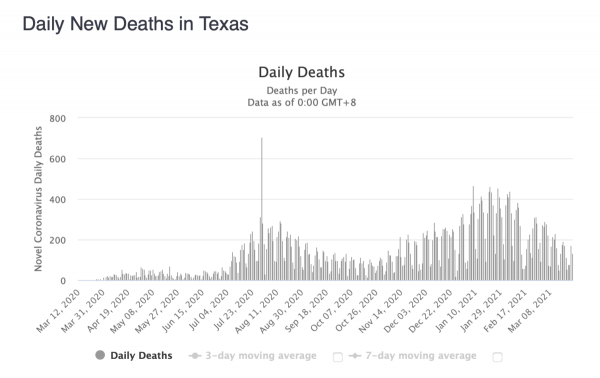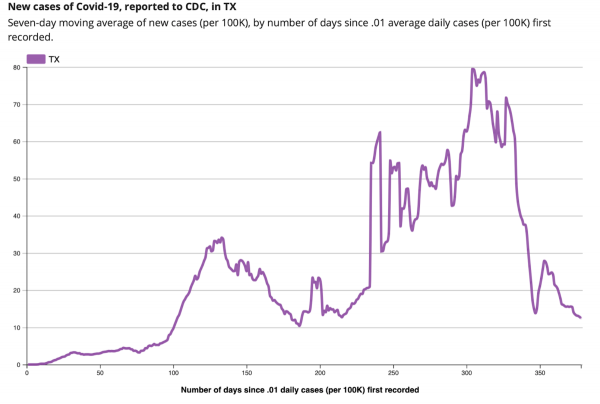Why is everyone in Texas not dying?
04/05/2021 / By News Editors

I’m sitting at a bar in Texas, surrounded by maskless people, looking at folks on the streets walking around like life is normal, talking with nice and friendly faces, feeling like things in the world are more-or-less normal. Cases and deaths attributed to Covid are, like everywhere else, falling dramatically.
(Article by Jeffrey A. Tucker republished from AIER.org)
If you pay attention only to the media fear campaigns, you would find this confusing. More than two weeks ago, the governor of Texas completely reversed his devastating lockdown policies and repealed all his emergency powers, along with the egregious attacks on rights and liberties.
There was something very un-Texan about those lockdowns. My hotel room is festooned with pictures of cowboys on horses waving guns in the air, along with other depictions of rugged individualism facing down the elements. It’s a caricature but Texans embrace it. Then a new virus came along – as if that had never happened before in Texas – and the new Zoom class took the opposite path, not freedom but imposition and control.
After nearly a year of nonsense, on March 2, 2021, the governor finally said enough is enough and repealed it all. Towns and cities can still engage in Covid-related mischief but at least they are no longer getting cover from the governor’s office.
At that moment, a friend remarked to me that this would be the test we have been waiting for. A complete repeal of restrictions would lead to mass death, they said. Would it? Did the lockdowns really control the virus? We would soon find out, he theorized.
I knew better. The “test” of whether and to what extent lockdowns control the virus or “suppress outbreaks” (in Anthony Fauci’s words) has been tried all over the world. Every serious empirical examination has shown that the answer is no.
The US has many examples of open states that have generally had better performance in managing the disease than those states that are closed. Georgia already opened on April 24, 2020. South Dakota never shut down. South Carolina opened in May. Florida ended all restrictions in September. In every case, the press howled about the coming slaughter that did not happen. Yes, each open state experienced a seasonality wave in winter but so did the lockdown states.
So it was in Texas. Thanks to this Twitter thread, and some of my own googling, we have a nice archive of predictions about what would happen if Texas opened.
- California Governor Gavin Newsom said that opening Texas was “absolutely reckless.”
- Gregg Popovich, head coach of the NBA San Antonio Spurs, said opening was “ridiculous” and “ignorant.”
- CNN quoted an ICU nurse saying “I’m scared of what this is going to look like.”
- Vanity Fair went over the top with this headline: “Republican Governors Celebrate COVID Anniversary With Bold Plan to Kill Another 500,000 Americans.”
- There was the inevitable Dr. Fauci: “It just is inexplicable why you would want to pull back now.”
- Robert Francis “Beto” O’Rourke of Texas revealed himself to be a full-blown lockdowner: It’s a “big mistake,” he said. “It’s hard to escape the conclusion that it’s also a cult of death.” He accused the governor of “sacrificing the lives of our fellow Texans … for political gain.”
- James Hamblin, a doctor and writer for the Atlantic, said in a Tweet liked by 20K people: “Ending precautions now is like entering the last miles of a marathon and taking off your shoes and eating several hot dogs.”
- Bestselling author Kurt Eichenwald flipped out: “Goddamn. Texas already has FIVE variants that have turned up: Britain, South Africa, Brazil, New York & CA. The NY and CA variants could weaken vaccine effectiveness. And now idiot @GregAbbott_TX throws open the state.” He further called the government “murderous.”
- Epidemiologist Whitney Robinson wrote: “I feel genuinely sad. There are people who are going to get sick and die bc of avoidable infections they get in the next few weeks. It’s demoralizing.”
- Pundit Bill Kristol (I had no idea that he was a lockdowner) wrote: “Gov. Abbott is going to be responsible for more avoidable COVID hospitalizations and deaths than all the undocumented immigrants coming across the Texas border put together.”
- Health pundit Bob Wachter said the decision to open was “unforgivable.”
- Virus guru Michael Osterholm told CNN: “We’re walking into the mouth of the monster. We simply are.”
- Joe Biden famously said that the Texas decision to open reflected “Neanderthal thinking.”
- Nutritionist Eric Feigl-Ding said that the decision makes him want to “vomit so bad.”
- The chairman of the state’s Democratic Party said: “What Abbott is doing is extraordinarily dangerous. This will kill Texans. Our country’s infectious-disease specialists have warned that we should not put our guard down, even as we make progress towards vaccinations. Abbott doesn’t care.”
- Other state Democrats said in a letter that the decision was “premature and harmful.”
- The CDC’s Rochelle Walensky didn’t mince words: “Please hear me clearly: At this level of cases with variants spreading, we stand to completely lose the hard-earned ground we have gained. I am really worried about reports that more states are rolling back the exact public health measures we have recommended to protect people from COVID-19.”
There are probably hundreds more such warnings, predictions, and demands, all stated with absolute certainty that basic social and market functioning is a terrible idea. The lockdown lobby was out in full force. And yet what do we see now more than two weeks out (and arguably the lockdowns died on March 2, when the government announced the decision)?
Here are the data.


The CDC has a very helpful tool that allows anyone to compare open vs closed states. The results are devastating for those who believe that lockdowns are the way to control a virus. In this chart we compare closed states Massachusetts and California with open states Georgia, Florida, Texas, and South Carolina.

What can we conclude from such a visualization? It suggests that the lockdowns have had no statistically observable effect on the virus trajectory and resulting severe outcomes. The open states have generally performed better, perhaps not because they are open but simply for reasons of demographics and seasonality. The closed states seem not to have achieved anything in terms of mitigation.
On the other hand, the lockdowns destroyed industries, schools, churches, liberties and lives, demoralizing the population and robbing people of essential rights. All in the name of safety from a virus that did its work in any case.
As for Texas, the results so far are in.

I’m making no predictions about the future path of the virus in Texas. Indeed for a full year, AIER has been careful about not trying to outguess this virus, which has its own ways, some predictable and some mysterious. The experience has, or should have, humbled everyone. Political arrangements seem to have no power to control it, much less finally suppress it. The belief that it was possible to control people in order to control a virus produced a calamity unprecedented in modern times.
What’s striking about all the above predictions of infections and deaths is not just that they were all wrong. It’s the arrogance and confidence behind each of them. After a full year and directly observing the inability of “nonpharmaceutical interventions” to manage the pathogen, the experts are still wedded to their beloved lockdowns, unable or unwilling to look at the data and learn anything from them.
The concept of lockdowns stemmed from a faulty premise: that you can separate humans, like rats in cages, and therefore control and even eradicate the virus. After a year, we unequivocally know this not to be true, something that the best and wisest epidemiologists knew all along. Essential workers still must work; they must go home to their families, many in crowded living conditions. Lockdowns do not eliminate the virus, they merely shift the burden onto the working class.
Now we can see the failure in black, white, and full color, daily appearing on our screens courtesy of the CDC. Has that shaken the pro-lockdown pundit class? Not that much. What an amazing testament to the stubbornness of elite opinion and its bias against basic freedoms. They might all echo the words of Groucho Marx: “Who are you going to believe, me or your own eyes?”
Read more at: AIER.org
Submit a correction >>
Tagged Under:
cases, coronavirus, COVID, data, infections, outbreak, pandemic, Texas
This article may contain statements that reflect the opinion of the author
RECENT NEWS & ARTICLES
Infections.News is a fact-based public education website published by Infections News Features, LLC.
All content copyright © 2018 by Infections News Features, LLC.
Contact Us with Tips or Corrections
All trademarks, registered trademarks and servicemarks mentioned on this site are the property of their respective owners.





















